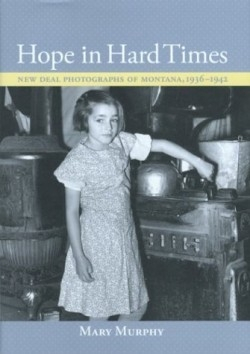Hope in Hard Times
New Deal Photographs of Montana 1936-1942
“Nobody had any money. You could buy a set of overalls for 25 cents [but] nobody had 25 cents,” recalled a Montana man in the 1930s. That’s the Depression-era Montana captured on film by photographers sent by Washington, D.C. administrators to “show city people what it’s like to live on a farm.”
In the eight-year existence of this early project of the Farm Security Administration’s (FSA) Historical Section, more than 77,000 photographs were taken around the United States. Some of the more frequently published—such as Dorothea Lange’s 1936 ’Migrant Mother,“ a portrait of a weary and weathered mother of seven in California—have become synonymous with the FSA photography project.
The author, a historian with Montana State University at Bozeman, has put together a retrospective of 136 of the photographs taken in Montana during those years, mixing history, politics, and personality.
The book is divided into three sections: a brief introduction explaining the FSA project (“Photographing History”); an in-depth history of the Depression’s effect on Montana’s farmers, ranchers, and other residents (“Hard Times”); and the stories behind the four FSA photographers who traveled throughout the state (“On the Road”).
Murphy explains that the mission of FSA photographers changed from creating a pictorial history of agriculture to subtly drumming up support for FDR’s New Deal relief programs. Photos ran in such popular publications as Life, Look, and Saturday Evening Post.
It’s Murphy’s culling from many diverse sources, though, that makes this an exceptional book. For instance, readers learn about the Danish immigrant colony of Dagmar, in eastern Montana’s Valley County, which was settled in two days in 1906 by six Danes who essentially just jumped off the train. This information is derived from records of the Works Progress Administration (WPA), another important New Deal program.
Also interesting is information that photographer John Vachon acquired while filming the castration of young lambs and his foray into the Rocky Mountain Laboratory, where research on Rocky Mountain Spotted Fever had been ongoing since 1902. Photographer Arthur Rothstein recalled later: “I would meet people on the road and then have to drop them. They would go back to their lives, and I would go on to something new.”
Because he and the others did “go on to something new,” viewers seventy years later are able to catch a small glimpse of a time and place from our nation’s history.
Disclosure: This article is not an endorsement, but a review. The publisher of this book provided free copies of the book to have their book reviewed by a professional reviewer. No fee was paid by the publisher for this review. Foreword Reviews only recommends books that we love. Foreword Magazine, Inc. is disclosing this in accordance with the Federal Trade Commission’s 16 CFR, Part 255.

